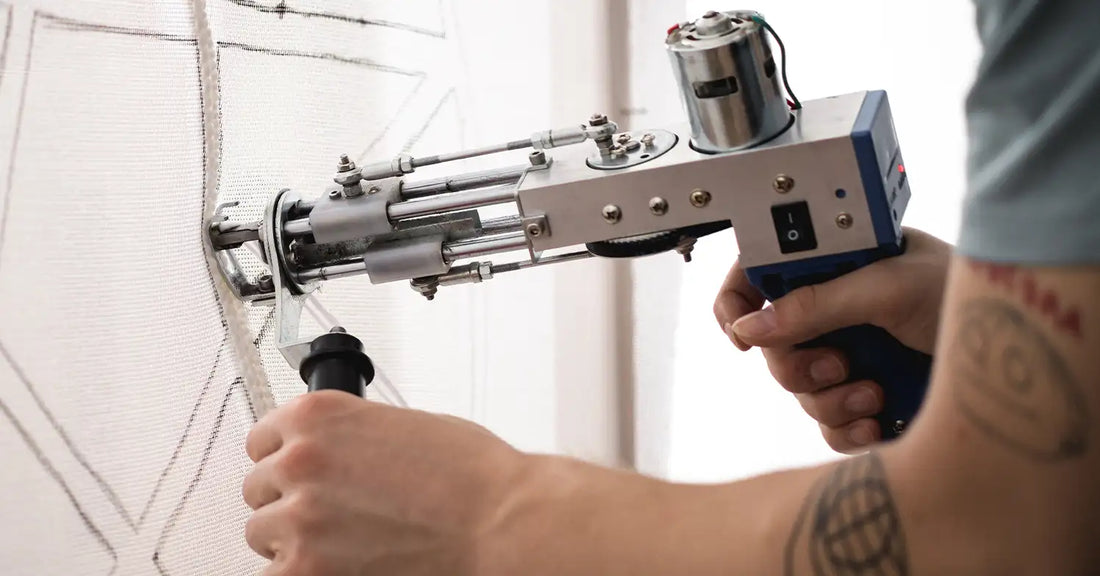What is Rug Tufting and How Does it Work?

Rug tufting is an intricate craft that involves pulling loops of yarn or fabric through a base material to create a pile or pattern. It's been around for centuries, but modern technology has made it easier and more accessible than ever before.
Table of Contents
- How Does Rug Tufting Work?
- The Rug Tufting Process
- Rug Tufting Tools and Equipment
- Rug Tufting Tips and Techniques
- Rug Tufting Techniques
- Rug Tufting Tips
- Other Rug Making Techniques
- FAQ
How Does Rug Tufting Work?
The rug tufting process starts with a base fabric, which can be made of a variety of materials such as cotton, linen, or burlap. The fabric is stretched tightly over a frame and a design is drawn onto it. Then, using a special tool called a tufting gun or tufting machine, loops of yarn or fabric are pushed through the fabric from the back to the front, creating a loop on the other side. This process is repeated thousands of times, creating a dense pile on the front of the fabric that is then cut to create the finished rug.
The Rug Tufting Process
Transforming yarn into beautiful tufted rugs is a precise and intricate process. From designing the pattern to finishing the edges, each step requires skill, patience, and attention to detail. Understanding the rug tufting process is essential for creating a quality product that will last for years to come.
Preparing the Fabric
The first step is to prepare the fabric, which serves as the base for the rug. The most common type of fabric used for tufting is monk's cloth, which is a durable and thick material that provides a stable foundation for the yarn. Before beginning the tufting process, the fabric must be properly stretched and secured to a frame to prevent any shifting or buckling.
Designing the Pattern
The next step is to design the pattern of the rug. This can be done by hand-drawing or using a software program. Once the pattern is finalized, it can be transferred onto the prepared fabric using a pen or marker. This acts as a guide for the tufting process and ensures that the finished product is a faithful representation of the original design.
Tufting the Yarn
The actual tufting process involves pushing yarn through the fabric using a tufting gun. A tufting gun is a handheld device that looks like a large needle with a handle. Yarn is fed through the tufting gun which works works by punching yarn through a base fabric to create loops which are then cut to produce the pile of the rug. As this process is repeated and the yarn is tufted into the designated areas, the design begins to take shape.
Finishing Touches
After all the yarn has been tufted into place, the final step is to finish the edges of the rug. This can be done in a variety of ways, including glueing or binding the edges with thread or adding a backing material to secure the yarn. The finishing touches not only give the rug a professional look but also protect it from fraying and wear and tear over time.
card insert how to tuft a rug step by step guide
Rug Tufting Tools and Equipment
Having the right tools and equipment is crucial for successfully tufting a rug. The supplies required for rug tufting include a tufting gun, yarn, a frame with fabric stretched over it, scissors, a threader, and a pencil. The type of yarn and fabric used significantly contributes to the overall look of the finished product. Choosing high-quality and durable supplies is critical in creating a beautiful and long-lasting rug.
Tufting Gun
One of the most essential tools for rug tufting is the tufting gun, which is used to quickly and accurately insert yarn into the fabric. The tufting gun works by using a needle to punch the yarn through the fabric, creating loops on the other side. This tool comes in manual, electric, and pneumatic formats, and can produce cut or loop piles to accomodate design patterns.
Yarn
Any type of yarn can technically be used to create tufted rugs, but for best results with a tufting gun, I recommend wool, cotton, or acrylic yarn. The type of yarn you use will impact the texture and durability of your object, as well as how smoothly your tufting process will go. It's important to choose a yarn that's strong and durable, so it can stand up to foot traffic.
Frame & Fabric
In order to use a tufting gun, you must stretch a foundation fabric tightly across a frame. Then you can use the tufting gun to feed yarn through the backing fabric, creating a pattern. The main options are: primary tufting cloth in gray and white, monk's cloth, and burlap. There’s no required shape or size for a tufting frame – this is all based on your individual needs and capabilities. The main components that make up a tufting frame are wood slabs like 2x4s, nails, and carpet tacking strip.
Other Tools and Equipment
Other tools and equipment needed for rug tufting include:
- Glue for securing the back of your rug
- Scissors for cutting the yarn
- Threader for feeding the yarn through your tufting gun
- Tape measure for measuring the fabric and yarn
- Bobbins for holding the yarn
Having the right supplies and tools is key to achieving a professional-looking rug
Rug Tufting Techniques
Rug tufting techniques vary depending on the desired pattern and texture of the rug. Some techniques involve using different colors of yarn or fabric to create intricate designs, while others use varying pile heights to add depth and texture.
Loop Pile Technique
The loop pile technique creates a looped appearance on the rug's surface. This technique involves pulling the yarn through the fabric and creating a loop.
Cut Pile Technique
The cut pile technique involves cutting the loops formed in the loop pile technique to create a plush surface.
Combination Pile Technique
The combination pile technique is a mix of both the loop pile and cut pile techniques. This technique creates a rug with textured and defined patterns. It is ideal for creating unique designs that stand out.
Rug Tufting Patterns
Rug tufting patterns refer to the various designs and shapes created on the rug's surface. There are numerous patterns, from simple to complex. Some of the popular patterns include stripes, chevron, floral, geometric, and abstract designs.
inpiration photos
Rug Tufting Tips
If you're new to rug tufting, it can be overwhelming to know where to start. These tips and techniques will help you on your journey to creating beautiful rugs:
- Choose the right yarn: The type of yarn you use can affect the overall look and feel of your rug. Consider factors such as texture, weight, and color when selecting your yarn.
- Practice good tension: Maintaining proper tension is essential for achieving even and consistent tufts. Experiment with different tensions to find what works best for you.
- Use efficient yarn placement: Proper yarn placement can save you time and increase your productivity. Practice efficient yarn placement techniques, such as tufting in rows or using a zigzag pattern.
- Don't be afraid to experiment: Rug tufting is a creative process, so don't be afraid to try new patterns and techniques. Remember, mistakes can often lead to new and exciting discoveries!
Rug tufting is a skill that takes time and practice to master, but with the right techniques and tools, anyone can create beautiful, high-quality rugs for their home.
Other Rug Making Techniques
There are many different techniques that can be used to create a rug. The most common techniques are tufting, hooking, and weaving. Tufting is the process of creating a pile by pushing yarn through a fabric backing, while weaving involves interlacing yarns to form a cohesive fabric. Knotting, on the other hand, involves tying yarns together to create a textured surface. There are many other rug making techniques that are not as common as tufting, hooking, and weaving. Some of these include braiding, knotting, and applique. Each of these techniques can be used to create unique and beautiful rugs.
FAQ
What is rug tufting and how does it work?
Rug tufting is an art that involves transforming ordinary wool into beautiful rugs using various techniques and tools. It is a process where yarn is inserted into a fabric base using a tufting gun or a tufting machine to create a pile. The yarn is then secured in place with adhesive or backing material, resulting in a plush and durable rug.
What are the different rug tufting techniques?
There are various rug tufting techniques that can be used to create unique patterns and designs. Some popular techniques include cut pile tufting, loop pile tufting, and combination tufting. Each technique has its own characteristics and contributes to the overall aesthetic of the finished rug.
What tools and equipment are used in rug tufting?
The essential tools and equipment used in rug tufting include a tufting gun or tufting machine, yarn or wool, a fabric base, and adhesive or backing material. The tufting gun or machine is used to insert the yarn into the fabric base, while the adhesive or backing material helps secure the yarn in place.
What is the rug tufting process?
The rug tufting process involves several steps. First, the fabric base is prepared by stretching it tightly on a frame. Then, a design is created on the fabric using a template or by freehand drawing. The yarn is then inserted into the fabric using a tufting gun or machine, following the design. Once all the yarn has been tufted, the rug is finished by securing the yarn with adhesive or backing material and applying any necessary finishing touches.
Are there any tips and techniques for rug tufting?
Absolutely! To enhance your rug tufting skills, consider efficient yarn placement, proper tensioning of the yarn, and troubleshooting common issues. Experiment with different techniques and practice regularly to achieve professional-looking results.
Can I try rug tufting as a beginner?
Yes, rug tufting can be enjoyed by beginners as well. With step-by-step instructions and valuable insights, you can embark on your own DIY rug tufting projects. Start with smaller designs and gradually work your way up to larger rugs as you gain more experience.
What are the advantages of hand-tufted rugs?
Hand-tufted rugs showcase unique beauty and craftsmanship. They offer a wide variety of designs, patterns, and color options. Hand-tufted rugs are also known for their plushness and durability, making them a great choice for homes and spaces that require both style and functionality.
Are there other rug making techniques besides tufting?
Yes, besides tufting, there are other rug making techniques such as weaving and knotting. Each technique has its own characteristics and results in distinct rug styles. If you're interested in exploring other methods, consider learning about these techniques and how to use a tufting gun effectively.
What is the importance of rug tufting and rug making?
Rug tufting and rug making are important crafts that allow for the creation of beautiful and functional pieces for your home. They enable individuals to express their creativity, showcase unique designs, and add warmth and style to their living spaces. Rug making also preserves traditional craftsmanship and provides employment opportunities within the industry.















